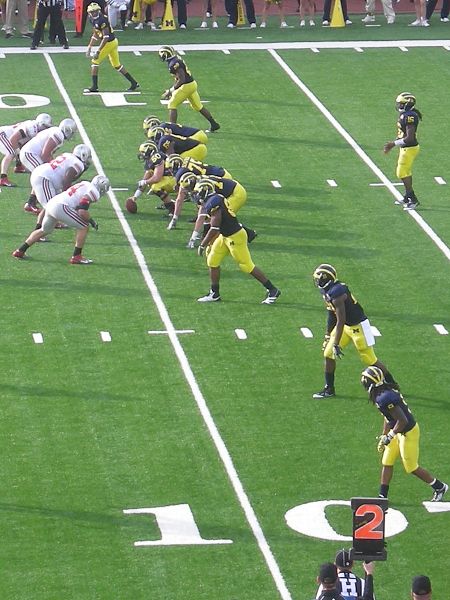2.11 Behavioral Traits of a Leader
Since charisma and vision are key traits of leaders, along with the ability to grow an organization, there are some classic, behavioral traits of a leader within a learning organization. A host of phrases that come to mind when thinking about what successful leadership include:[1]
- Drive
- Creativity
- Self-Confidence
- Cognitive Ability
- Job-Relevant Knowledge
- Motivation
- Flexibility
- Honesty and Integrity
The ability to encompass all of these behaviors is an interesting study in their effectiveness in organizations. During the 1940’s, there were two institutions that sought to bring the understanding of behavior and leadership together. It was more of a collaborative effort between these two schools, much different from how they see each other on the football field.

The Ohio State Studies
In Columbus, Ohio, researchers were looking for a way to identify leadership behaviours in relation to performance. They developed two major set of behavioural structures:[2]
- Consideration: the relationship-oriented behavior of a leader: supportive, friendly, and representing the interest of the people
- Initiating Structure: the task-oriented behavior of a leader: planning, coordinating, and maintaining standards of performance
Through this study, it was found that leaders can differ from these two groupings in almost a binary way. One way to connect this to a learning organization is to look at a professor and how he or she teaches the class. Is the class more of a collaborative and supportive environment that represents the interest of the students, or is the class methodical, structural, and focuses on the grades or results of the students? Regardless of the framework, the Ohio State Studies outlined two critical frameworks for understanding different types of leadership, and the impact that leadership has on members within the organization.[3]
The Michigan Studies
At the same time in Ann Arbor, Michigan, researchers were at work trying to identify leadership behaviours that differentiated effective from ineffective leaders. What was discovered were two types:[4]
- Job-Centered Behaviors: devoted to supervisory functions such as planning, scheduling, and providing resources.
- Employee-Member-Centered Behaviors: devoted to consideration and support for members within the organization.
Similarities between the Ohio State Study and the Michigan Study show ways that focus on leadership behaviors either being tailored toward the company or the individual. What the Michigan Study shows is a mix between care for the job, which is beneficial for the employees, or care for the employee, which is beneficial for the organization.
Both institutions created a logic that deduces behavior to a central focus that encompasses all of the traits. Robert R. Blake and Jane S. Moulton developed a leadership grid to show all of the different styles reflected upon by the Ohio State and Michigan studies.
Activity: Case Study
- In this activity you will read the case study and provide answers in relation to the discussion questions.
- You can use the text box at the bottom of the page to input answers.
- If available, tackling this case will work better in groups and answering questions as a collective.
Source: The Children, Youth, and Families At-Risk (CYFAR), University of Minnesota, https://cyfar.org/ilm_8_casestudy1
Leadership and Management Case Study #1
Laura is the associate director of a nonprofit agency that provides assistance to children and families. She is the head of a department that focuses on evaluating the skill-building programs the agency provides to families. She reports directly to the agency leadership. As a whole, the agency has been cautious in hiring this year because of increased competition for federal grant funding. However, they have also suffered high staff turnover. Two directors, three key research staff, and one staff person from the finance department have left.
Laura has a demanding schedule that requires frequent travel; however, she supervises two managers who in turn are responsible for five staff members each. Both managers have been appointed within the last six months.
Manager 1: Kelly has a specific background in research. She manages staff who provide research support to another department that delivers behavioral health services to youth. Kelly supports her staff and is very organized; however, she often takes a very black and white view of issues. Upper level leadership values Kelly’s latest research on the therapeutic division’s services. Kelly is very motivated and driven and expects the same from her staff.
Manager 2: Linda has a strong background in social science research and evaluation. She manages staff that work on different projects within the agency. She is known as a problem solver and is extremely supportive of her staff. She is very organized and has a wealth of experience in evaluation of family services. Linda is very capable and can sometimes take on too much.
The managers are sensing that staff are becoming overworked as everyone takes on increased responsibilities due to high staff turnover. Staff have also mentioned that Laura’s “glass half-empty” conversation style leaves them feeling dejected. In addition, Laura has not shared budgets with her managers, so they are having difficulty appropriately allocating work to staff. Laura said she has not received sufficient information from the finance department to complete the budgets. The finance department said they have sent her all the information they have available.
As staff become distressed, the managers are becoming frustrated. They feel like they are unable to advocate for their staff or solve problems without key information like the departmental budget.
Discussion Questions
- How can Laura most effectively use both management and leadership skills in her role as associate director? What combination of the two do you think would work best in this setting?
- What steps could be taken to build staff confidence?
- What advice would you give Laura on improving her leadership skills and to the managers on improving their management skills?
- Which leadership style do you think a leader would need to be effective in this situation?
Note on Attribution
Chapter 2.11 Behavioural Traits of a Leader was adapted from “Chapter 3.3, Behavioural Traits of a Leader – Leadership and Management in Learning Organizations” by Clayton Smith, Carson Babich, and Mark Lubrick, licensed under CC BY-NC-SA 4.0.
- Kirkpatrick, S. A., & Locke, E. A. (1991). Leadership: Do traits matter? Academy of Management Executive 5(2), 48-60. https://sites.fas.harvard.edu/~soc186/AssignedReadings/Kirkpatrick-Traits.pdf ↵
- Openstax, Principles of Management (2019, May 31). https://cnx.org/contents/w6yyq31c@8.84:HUc6el9I@6/13-5-Behavioral-Approaches-to-Leadership ↵
- Ibid. ↵
- Ibid. ↵

